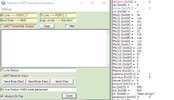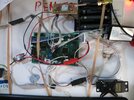'18F4431 32MHz XTL REMOTE_SLAVE 164 160223 2330
Define CONFIG1L = 0x00
Define CONFIG1H = 0x06 '8mHz XTL x4 =32mHz
Define CONFIG2L = 0x0c
Define CONFIG2H = 0x20
Define CONFIG3L = 0x04
Define CONFIG3H = 0x80
Define CONFIG4L = 0x80 'Set for HVP
Define CONFIG4H = 0x00
Define CONFIG5L = 0x0f
Define CONFIG5H = 0xc0
Define CONFIG6L = 0x0f
Define CONFIG6H = 0xe0
Define CONFIG7L = 0x0f
Define CONFIG7H = 0x40
Define CLOCK_FREQUENCY = 32
Define SINGLE_DECIMAL_PLACES = 2
Define STRING_MAX_LENGTH = 20
Define SIMULATION_WAITMS_VALUE = 1 'Comment in for SIM out for PIC
Dim wordTemp As Word
Dim servoCount As Byte
Dim i As Word
Dim servoPos(8) As Word
Dim servoDir(8) As Byte
Dim frame As Word
Dim buff(80) As Byte
Dim strCount As Byte
Dim rec As Byte
Dim isDone As Bit
Dim cnt As Byte
dim fifo(16) as byte
dim fifoStart as byte
dim fifoEnd as byte
Dim ccpDone As Bit
Dim previous as Bit
Dim TXbyte as byte
Dim bitCount as byte
Dim ms as long
Dim tick as long
Dim str as string
OSCCON = %01110000 '& h70
gosub initIO
gosub initServos
gosub initSerial
gosub initTMR1
gosun initTMR2
tick=0
ms=0
INTCON=0xc0 'only PEIE and GIE set
pause(2) 'let serial flush and get stable
str="$test stringW"
for i=0 to len(str)-1
call putFifo(str(i))
next i
While 1
'adjust servo positions here
INTCON.GIE=0 'disable interrupts so ms can't change
if (ms-tick)>50 then
tick=ms
For i = 0 To 7
INTCON.GIE = 0
If servoDir(i) = 1 Then
servoPos(i)=servoPos(i)+40 'add 1/50th to the servo position
Else
servoPos(i)=servoPos(i)-40 'subtract it
Endif
If servoPos < 2000 Then 'have we gone past the end?
servoPos(i) = 2000 'yes so make it the end stop
servoDir(i) = 1 'and turn it around
Endif
If servoPos(i)>4000 Then 'same for other end
servoPos(i) = 4000
servoDir(i) = 0
Endif
INTCON.GIE = 1
Next i
endif
INTCON.GIE=1
If isDone then
'put a break here and see what's in buff.
'deal with the received sentence here
'This code can be any length but ideally less than 20mS
isDone=0
Endif
'other code here.
Wend
End
proc putFifo(dat as byte)
while ((fifoEnd-fifoStart) AND 0x0f)=0x0f
wend
fifo(fifoEnd)=dat 'add data to queue
fifoEnd=(fifoEnd+1) AND 0x0f 'and increment pointer
End Proc
function getFifo() as byte 'note, doesn't test if fifo is empty
getFifo=fifo(fifoStart) 'so always call getFifoLen first
fifoStart=(fifoStart+1) AND 0x0f
End Function
function getFifoLen() as byte
getFifoLen=(fifoEnd-fifoStart) AND 0x0f
End Function
initSerial:
'setup USART for 9600 baud receive
RCSTA = %10010000
TXSTA.BRGH = 1
SPBRG = 207
PIR1.RCIF = 0
BAUDCON.BRG16 = 1
PIE1.RCIE = 1
PIE1.RCIE = 1
strCount = 0
isDone = 0
ccpDone = 1
return
initServos:
LATC.0 = 0 'ensure data is low
LATC.2 = 0 'and clock
For i = 0 To 7
LATC.2 = 1 'send positive clock edge
servoPos(i) = i * 250 + 2000 '1ms(2000) to 1.875(1 7/8ths - 3750)ms in 1/8th mS steps
LATC.2 = 0 'send negative edge
servoDir(i) = i And 1 '<<<<<<<added
Next i
servoCount = 8 'cause it to reset
CCP1CON = %1000 'will go high on interrupt - will start a 0.5mS pulse
frame = 1000 'start everything in 4000 cycles
return
initTMR1:
T1CON = %00100000 'prescaler = 4
T1CON.0 = 1 'start timer
return
initTMR2:
'setup 1mS interrupt = 8,000,000/16 = 500,000/10 = 50,000 set PR2=49 = 50,000/50 = 1000 = 1mS
T2CON = %01001110 '& h4e
PR2 = 49 'This is timer 2 period register. I.E. reset after 50 clocks (0 to 49 = 50 counts)
PIE1.TMR2IE = 1 'timer 2 interrupts enable
return
initIO:
TRISA = %11000000 '7=OSC, 6=OSC,
TRISC = %11111000 '6=1-slave4431_cs, 2=74HC164 CLK, 0=74HC164 DATA 1=Serial out
TRISC = %11111010 'CCP0 (RC2) & RC0 output
return
On High Interrupt 'go via location 0x0008
Save System
if PIR2.CCP2IF Then
serialCount=serialCount+1
wordTemp.LB=CCPR2L 'ensure next interrupt is
wordTemp.HB=CCPR2H 'in 208*4=832 instruction cycles
wordTemp=wordTemp+208 '208 is 2,000,000/9600 = 104uS or the time for 1 bit at 9600 baud
CCPR2H=wordTemp.HB 'it's really important that the high byte gets written first
CCPR2L=wordTemp.LB 'write it back
LATC.1=PORTC.1 'ensure latch is same as current CCP output
if ccpDone then 'are we idle
bitCount=0 'yes so reset things
length=getFifoLen() 'is anything in the fifo?
if length>0 then 'yes so start a new transmision
TXbyte=getFifo() 'get byte to transmit
CCP2CON=%1001 'pin high and low on next interrupt = start bit
ccpDone=false 'tell everything we're no londer idle
previous=0 'set previous equal to start bit
Endif
else
'we're sending a byte
if bitCount<9 then 'have we done a complete byte
if TXbyte.0=previous then 'no so send next bit,
'just need the interrupt as next bit is same as previous bit
CCP2CON=%1010
else
'we need to flip the bit
if previous Then 'did we previously send a one?
'we need a zero next
previous=0 'we're sending a zero next
CCP2CON=%1001 'will go to zero next match
else
'we need a one next
previous=1 'we're sending a one next
CCP2CON=%1000 'will go to zero next match
endif
endif
TXbyte=shiftRight(TXbyte,1)'shift next bit to zero position
else
'doing the stop bits
if bitCount<10 then
if previous then
CCP2CON=%1010 'just need interrupt
else
previous=1
CCP2CON=%1000 'go high next interrupt
endif
else
ccpDone=true 'stop bits will still be generated - this happens at bitCount=10
Endif 'and output will stay high until next byte
Endif
Endif
bitCount=bitCount+1 'this will get reset if idle
PIR2.CCP2IF=0
Endif
If PIR1.TMR2IF Then 'Is it a timer 2 interrupt
Cnt = Cnt + 1 'Increment count
ms=ms+1 'increment milliSecond
If Cnt >= 5 Then 'Has 5mS passed without a byte being received
isDone=0
strCount=0
cnt=0
Endif
PIR1.TMR2IF = 0
Endif
If PIR1.CCP1IF Then 'has CCP1 triggered?
wordTemp.HB = CCPR1H 'get value of CCPR1 into wordTemp
wordTemp.LB = CCPR1L
If CCP1CON = 0x08 Then 'have we started the 1000 cycle pulse
CCP1CON = 0x09 'yes so end the pulse after 0.5mS
wordTemp = wordTemp + 1000 'adding 1000 will make pulse 0.5mS long
Else
LATC.0 = 0 'clear the data pin
CCP1CON = 0x08 'No so output the timed gap
If servoCount < 8 Then
'still doing the servos so add remainder of time
wordTemp = wordTemp + servoPos(servoCount)
wordTemp = wordTemp - 1000 'knock of the 1000 (0.5mS) already elapsed
frame = frame - servoPos(servoCount)
servoCount = servoCount + 1
Else
'done all the servos so just the frame gap to do
wordTemp = wordTemp + frame
frame = 39000 '40,000(20mS) minus time of positive pulse(0.5mS)
servoCount = 0 'start all over again
LATC.0 = 1 'will become first pulse
Endif
Endif
CCPR1H = wordTemp.HB 'put value back into CCPR1
CCPR1L = wordTemp.LB
PIR1.CCP1IF = 0 'clear interrupt flag
Endif
If PIR1.RCIF Then
cnt=0 'stop any timeout happening
rec = RCREG 'get the received character
If RCSTA.OERR Or RCSTA.FERR Then 'neither of these should ever occur.
RCSTA.CREN = 0 'this is kinda wishful thinking
while PIR1.RCIF 'if any bytes in the buffer
rec = RCREG 'throw them away
wend
RCSTA.CREN = 1 'as any data received is corrupt
strCount = 0 'however, reset everything
isDone = 0 'and hope for the best
Else 'no errors so use the data
'the following is waiting for a "$" sign
If strCount=0 Then 'are we already receiving
'waiting for $ 'no so wait
If rec = "$" Then 'for $ to appear
buff(strCount)=rec'start receiving
strCount = 1 'must have been zero previously
Endif
Endif
'the following gets executed if we've allready got a "$" sign
'but not got a "W" yet.
If isDone=0 And strCount<>0 Then
if strCount<80 then 'only store it if there's room in the buffer
buff(strCount)=rec 'no so carry on storing
strCount = strCount + 1 'this may cause strCount to get to 80 = buffer full
Endif
If rec = "W" Then 'have we got the "endOfString" character
isDone = 1 'yes, so set done true
Endif
Endif
If isDone=0 AND strCount>79 Then
'buffer has overflown
strCount = 0
Endif
Endif
Endif 'end RS232 if
Resume



